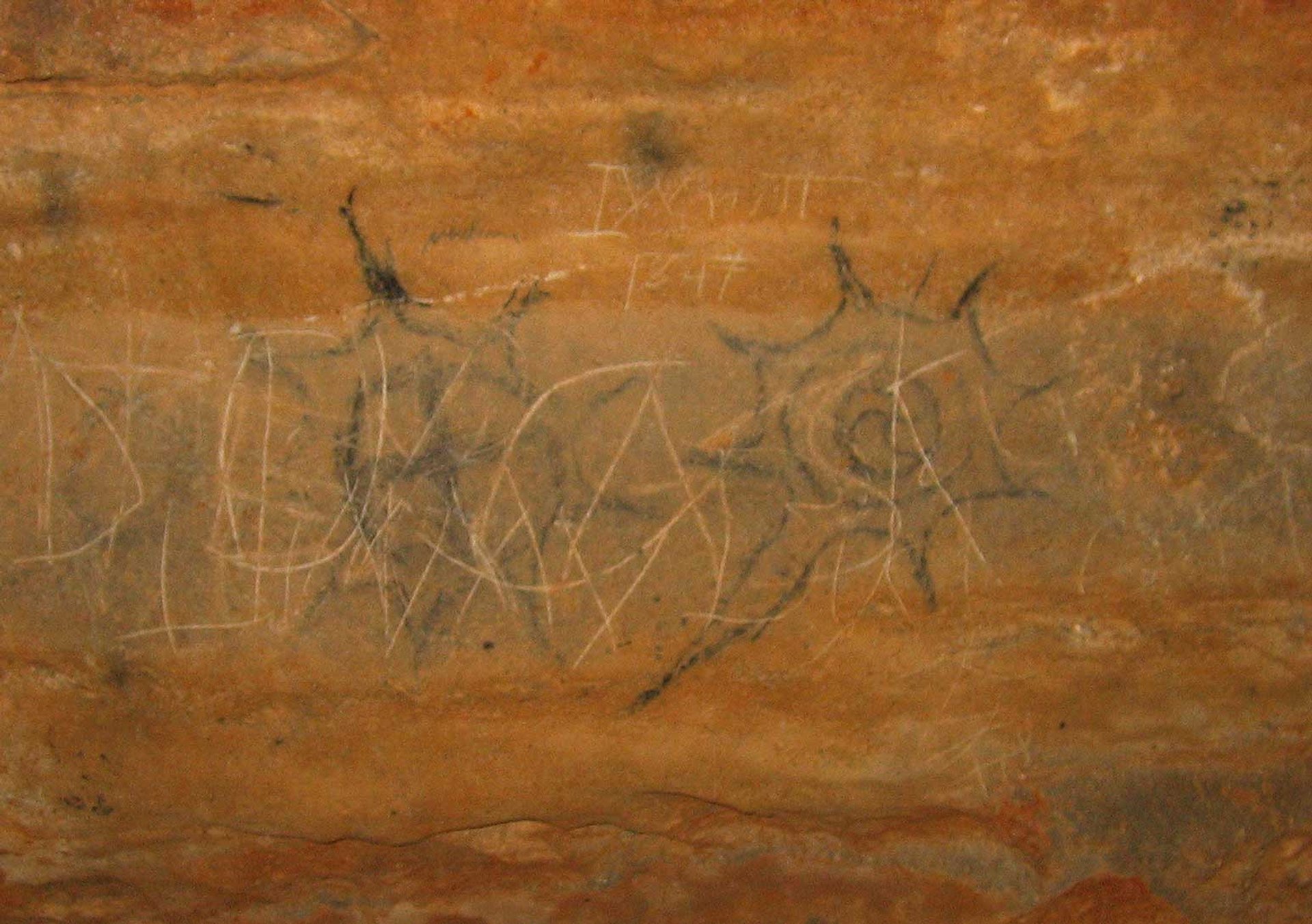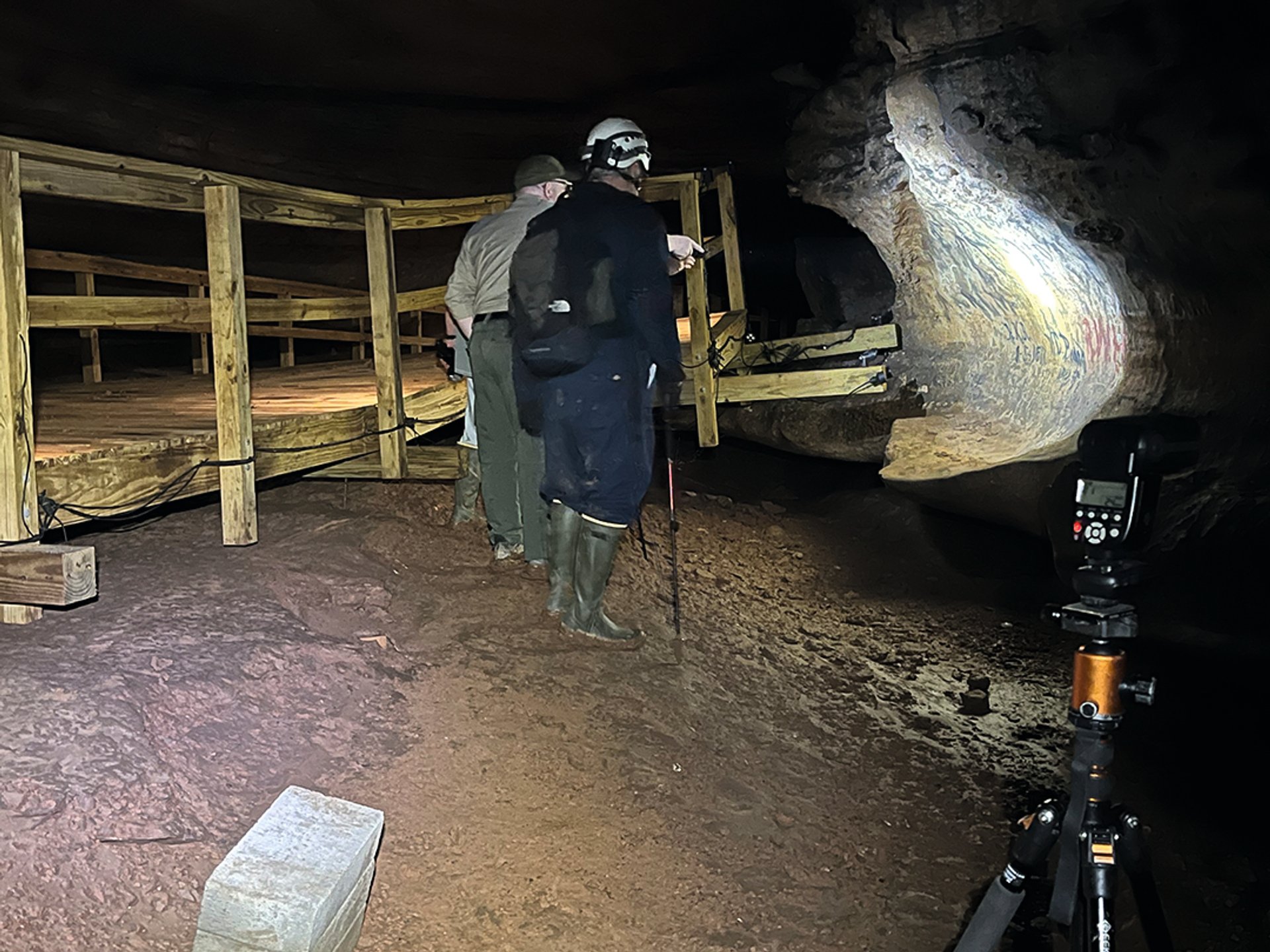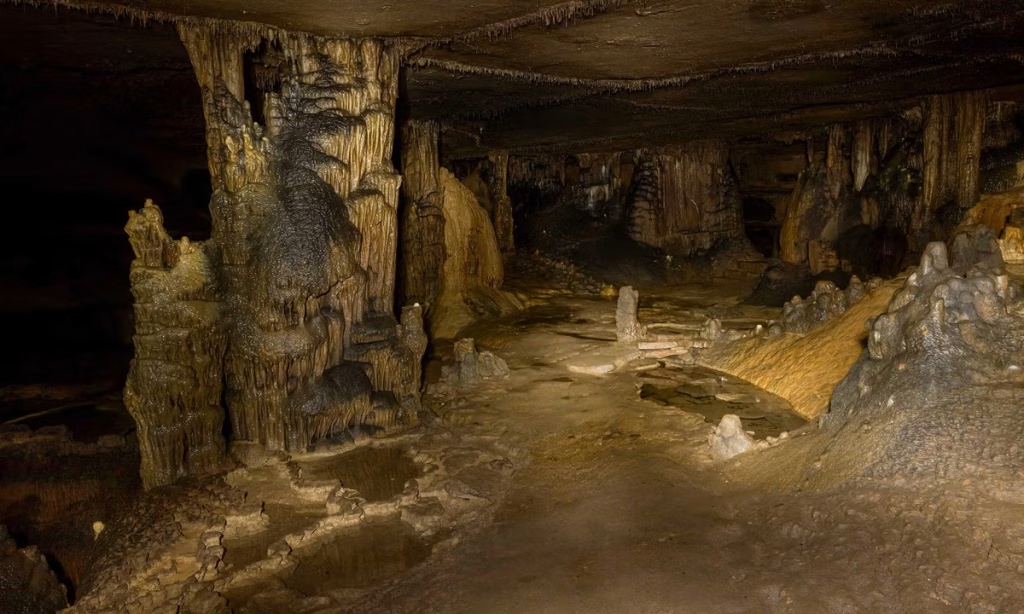Some of the oldest examples of cave art in the US are on the walls of Dunbar Cave in Clarksville, Tennessee—50 miles northwest of Nashville. Dating back around 800 years, these include petroglyphs carved into the limestone and pictographs drawn in charcoal that were identified in the early 2000s. Some have geometric, abstract forms—such as concentric circular shapes—while others feature human figures or possibly represent beings related to spiritual practice. The cave is believed to have been a sacred space for Indigenous people during the Mississippian period, spanning from roughly 500 to 1,000 years ago. Archaeological studies have revealed signs that the use of the cave by humans goes back even further—taking place over tens of thousands of years—from traces of the extraction of its mineral resources to evidence of the care of the dead. The cave, stretching eight miles underground, is now part of Dunbar Cave State Park.
In February, severe flooding from heavy rains completely submerged the cave art. Dunbar Cave State Park officials stated that it was the highest flooding in the cave on record, “several feet higher” than another major flood in 2010 and “the third such event in less than one year”. Images they posted online showed the aftermath: mud was caked on all sides of the cave, including the ceiling, with several bats found drowned. Restoration of the site’s damaged infrastructure is now underway in order to reopen the cave for public tours. Meanwhile, archaeologists have been assessing any damage to the cave art, as this was the first recorded time it had been completely covered during a flood.
Entrance to Dunbar Cave Photo: David Duplessis © TennesseePhotographs.com
According to information shared by the Tennessee Department of Environment and Conservation (TDEC), its Division of Archaeology (TDOA) has compared high-resolution photographs that were taken of the art in 2014 to those taken after the flooding. This analysis showed that there were no signs of the pigments having degraded or undergone structural damage from water and sediment rushing into the cave. TDOA also conducted a non-destructive evaluation of any changes in the art’s elemental or mineralogical nature using fibre-optic reflectance spectroscopy and portable X-ray fluorescence spectroscopy. This examination was compared to studies done in 2016, and it revealed no detectable changes in the art’s chemical composition.
As above, so below
Although the cave art does not appear to have been harmed, TDOA is planning regular monitoring for the potential impact of flooding as it becomes a more common occurrence. This could have indirect effects on the art as well, if the cave environment changes due to things like increases in ambient moisture and humidity. As part of this care, TDOA and Tennessee State Parks are continuing their ongoing work with Indigenous descendant communities, including the Eastern Band of Cherokee, in the preservation of this archaeological site.
“Protecting and stewarding irreplaceable archaeological features like that at Dunbar Cave is among the most important work that we do,” says Phil Hodge, a state archaeologist and director of TDOA. “And it’s more than merely preserving ancient pigments on a limestone cave wall; it’s about preserving the voices of Indigenous people who used this cave and held it sacred for thousands of years, and who remain connected to it in the present.”

Sacred shapes: the walls of Dunbar Cave—believed to have functioned as a spiritual space for Indigenous people 500-1,000 years ago—are decorated with both geometric forms and depictions of humans
Photo: TSP Marketing archives
Tennessee State Parks is also partnering with the US Geological Survey and the TDEC Division of Water to study the hydrology of the watershed in the area in an attempt to determine long-term solutions. Dunbar Cave is just one feature in a “karst” region—shaped by the dissolution of its limestone bedrock into caves, sinkholes and other features. (Tennessee is one of the most “karstified” areas of North America, and the state has thousands of known caves.) This causes a distinct relationship between water and a very porous ground; water has always been part of Dunbar Cave, but never at such extreme levels and so fast-moving.
How water is managed above influences everything that happens underground, and climate change—as well as development of the built environment—can have a significant impact on not only the future of the art at Dunbar Cave but also on its subterranean ecological habitat, a haven for rare animals like endangered grey bats, blind cave crayfish and southern cavefish. Restoring aspects of the environment surrounding the cave, like wetlands, could help mitigate damage from future major storms. For example, a recent proposal from state officials considered returning an artificial lake at Dunbar Cave State Park to its natural and more sustainable state as a free-flowing stream, which could better manage an increasing frequency of flash flooding. However, the Clarksville City Council voted in January to preserve the lake, which is used to irrigate a local golf course.

Inside Dunbar Cave Photo: TSP Marketing archives
“We have to ask: can we better educate the local public about the importance of watersheds and karst?” says David Britton, the park manager at Dunbar Cave State Park. “In this part of the country, our above-ground world is intrinsically connected to the world below our feet. Good stewardship ensures harmony and protection of not just cultural treasures like the cave art, but also the entire ecosystems that exist in caves. Our daily actions on the ground can have devastating consequences, even if we can’t immediately see the effects.”
After the flooding earlier this year, although some mud accumulated in Dunbar Cave’s passageways, much of the impact was on its infrastructure. Two large boardwalks were damaged after being dislodged by the floods. One of them provides visitor safety in a wet area of the cave, while the other prevents damage from foot traffic in an archaeological area. These are being reconstructed by a recovery team, in a way that is sustainable and intended to keep them from breaking loose again in future flooding.
The rebuilding of the boardwalks is being addressed before guided tours can restart. Tours are usually held seasonally from May to September and have included the cave art. They are the only such opportunity for the public to see Mississippian cave art in this rare place, where an underground cultural history and ecology are both cared for together.
